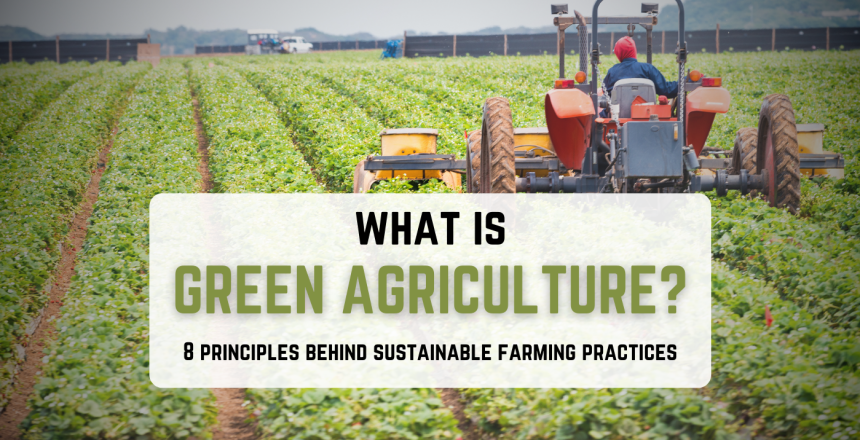As global environmental concerns, resource depletion, and climate change continue to challenge modern agriculture, farmers are increasingly seeking sustainable solutions that balance productivity with ecological responsibility. Green agriculture offers a framework that prioritizes environmental stewardship, efficient resource use, and social responsibility, aiming to create a farming system that benefits both people and the planet.
One emerging technology that aligns seamlessly with the principles of green agriculture is anaerobic digestion, particularly when used to process cattle manure and slurry. Combining green agriculture and manure digesters not only helps farmers manage waste more effectively but also generates renewable energy and produces valuable byproducts that support sustainable farming practices.
Understanding Green Agriculture
Green agriculture is an approach to farming that integrates environmental health, economic viability, and social equity. It seeks to meet today’s agricultural needs without compromising the ability of future generations to do the same. At its core, green agriculture focuses on preserving natural resources, reducing environmental impacts, and enhancing long-term soil and ecosystem health.
What is Green Agriculture?
Green agriculture emphasizes practices that ensure a balance between high yields and ecological preservation. It integrates technologies and methods that minimize harm to the environment while maintaining food security.
The Core Principles of Green Agriculture
Green agriculture can be summarized by eight key principles:
- Sustainable Farming Practices: Balancing productivity with practices that preserve soil health and natural resources over time.
- Biodiversity Conservation: Enhancing ecosystem resilience by maintaining a variety of species and promoting natural interactions.
- Soil and Water Management: Protecting water quality and soil fertility to prevent degradation and ensure long-term viability.
- Reduction of Chemical Inputs: Limiting synthetic fertilizers and pesticides in favor of natural alternatives.
- Renewable Energy Use: Integrating renewable energy sources like solar, wind, or biogas into farming operations.
- Climate Change Mitigation: Reducing greenhouse gas emissions and adapting to changing weather patterns through smart farming techniques.
- Animal Welfare: Ensuring that livestock are raised in humane, ethical conditions that promote health and well-being.
- Local and Organic Markets: Supporting local economies by selling produce directly to consumers and emphasizing organic practices.
Each of these principles supports a holistic approach to farming, ensuring that agriculture can be productive while protecting the environment and benefiting society.
—
How Green Agriculture and Anaerobic Digestion Work Together
In anaerobic digestion, microorganisms break down organic matter such as cattle manure and slurry in the absence of oxygen, typically in a climate-controlled heated containment unit. This process produces two key outputs: biogas, which can be used as renewable natural gas (RNG), and digestate, a nutrient-rich byproduct that serves as an organic fertilizer.
Anaerobic digestion offers a versatile solution for farmers looking to manage waste more sustainably while also producing renewable energy and enhancing soil health. By converting waste into valuable resources, anaerobic digestion aligns perfectly with the principles of green agriculture.
Sustainable Farming
Anaerobic digestion creates renewable energy from livestock waste, helping farms reduce their reliance on fossil fuels. This energy can be used to power farm operations, or it can be sold back to the grid, contributing to overall sustainability.\
In addition, the digestate produced through AD can be applied to fields as an organic fertilizer, promoting nutrient recycling and reducing the need for synthetic fertilizers.
Conserving Biodiversity
When manure is processed through anaerobic digestion, it reduces the risk of waste runoff into nearby ecosystems. This helps preserve local biodiversity by preventing water pollution that can harm aquatic ecosystems. Digestate-based fertilizer also improves soil health, encouraging a diverse microbiome that contributes to overall ecosystem balance.
Soil and Water Management
Anaerobic digestion helps farmers manage manure more effectively, reducing the risk of contaminating local water sources. The digestate left after biogas production is rich in nutrients and organic matter, making it an excellent fertilizer for improving soil fertility and structure. This ensures that both soil and water resources are protected and maintained.
Reduced Chemical Inputs
Digestate from anaerobic digestion is a natural fertilizer that can replace synthetic options, reducing the need for chemical inputs on the farm. It supplies essential nutrients like nitrogen, phosphorus, and potassium in a form that’s easier for plants to absorb. Healthier soils resulting from digestate use may also reduce the need for pesticides, as stronger crops can better resist pests and diseases.
Renewable Energy Sources
One of the most significant advantages of anaerobic digestion is its ability to produce renewable natural gas (RNG) from waste. This renewable energy source can be used on the farm or sold to the grid, helping farmers reduce their dependence on fossil fuels. Farms that adopt AD systems contribute to the broader goal of transitioning to renewable energy.
Climate Change
By capturing and converting methane into renewable natural gas, anaerobic digestion helps farms reduce their overall greenhouse gas emissions to a point that the process is actually carbon-negative. Additionally, the digestate improves soil’s ability to sequester carbon, further contributing to climate change mitigation.
Animal Welfare
Anaerobic digestion systems improve manure management, creating cleaner, healthier environments for livestock. Efficient manure processing reduces odors and ensures that waste is managed hygienically, reducing the risk of disease. This improved farm environment contributes to better overall animal welfare.
Local and Organic Markets
The digestate produced through anaerobic digestion is suitable for use in organic farming, allowing farmers to promote their products as organic and sustainable. This aligns with the increasing demand for eco-friendly and locally produced food. Farmers can also market their use of renewable energy, appealing to environmentally conscious consumers and strengthening their local economies.
Green Agriculture and Anaerobic Digestion in Action
Green agriculture and anaerobic digestion is a growing trend in South Dakota, with many large dairy farms implementing manure digesters into their overall agribusiness plans. Brooks has been working with several investment firms, technology providers, and engineering firms to build RNG digesters for dairies in eastern South Dakota.
Mill Valley Dairy (Milbank, SD)
This century-old dairy farm added RNG digesters in 2021 to manage cattle slurry and waste in an eco-friendly way.
- Two 105-foot diameter, 26-foot tall concrete digestion tanks
- One 36-foot diameter, 15-foot tall concrete receiving tank
- One 36-foot diameter, 15-foot tall concrete digestate tank
- 178,000+ tons of cattle slurry processed annually
- 70,226 MMBTUs of renewable natural gas annually
Learn more about Mill Valley Dairy
Full Circle Dairy (Hurley, SD)
Located in southeastern South Dakota, Full Circle Dairy contains and processes the waste from its 7,000 head of cattle in four large digesters to produce RNG and fertilizer.
- Four 105-foot diameter, 26-foot tall concrete digestion tanks
- Two 36-foot diameter receiving tanks
- One 41-foot diameter digestate tank
- 332,000 tons of cattle slurry processed annually
- 155,700 MMBTUs of renewable natural gas
Learn more about Full Circle Dairy
Athena Circularity Center (Baltic, SD)
This circularity center, situated at the center of three dairy farms, helps its owners improve sustainable practices while providing energy resources to gas pipelines that serve transportation and electricity needs throughout the nation.
- Serves 13,000 head of cattle across 3 dairy farms
- 462,000 tons of cattle slurry processed annually
- 217,000 MMBTUs of renewable natural gas annually
- CO2eq reduction of 64,000 tons annually
- Enough renewable energy to power more than 2,400 electric vehicles per year
Learn more about Athena Circularity Center
POET RNG Digester System (Estelline, SD)
This soon-to-be-completed digester system will help South Dakota’s POET reduce fossil fuel use and improve the carbon density of its biofuels by processing waste materials from nearby farming operations.
- Part of POET’s network of more than 30 biofuel plants across seven states
- Goal of reducing POET’s biofuel carbon intensity by 70% by 2030
- Will help power bioethanol and biofuel processing plants with RNG
- Direct bioproducts include bioethanol, animal feed, CO2 and dry ice, purified alcohol, and asphalt rejuvenator
Learn more about POET and biofuel production
Adding Green Agriculture and Anaerobic Digestion to Your Farm
Anaerobic digestion offers a powerful solution for farmers striving to meet the principles of green agriculture. By turning waste into renewable energy and organic fertilizer, AD not only addresses environmental concerns but also improves farm efficiency and sustainability. As the agricultural sector continues to evolve, technologies like anaerobic digestion will play an essential role in ensuring that farms remain productive while protecting the environment for generations to come.
Want to add manure digesters to your green farming plan? Brooks is ready to help! Contact us to find out how we can help you coordinate all the resources you’ll need to fund, build, and run an eco-friendly anaerobic digestion system on your farm.



